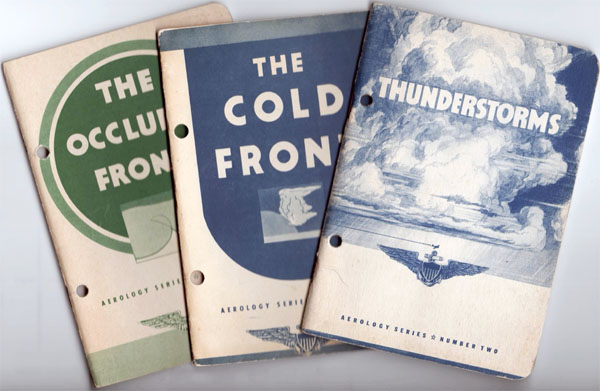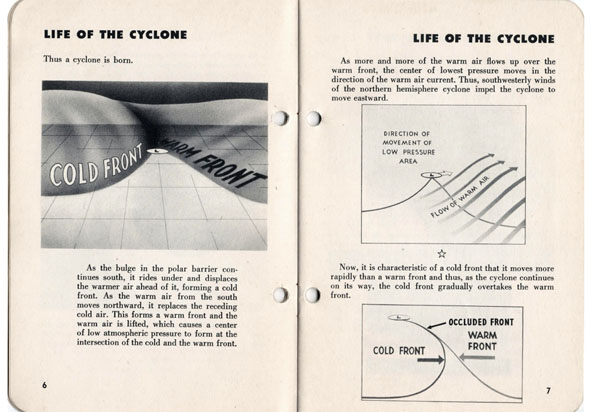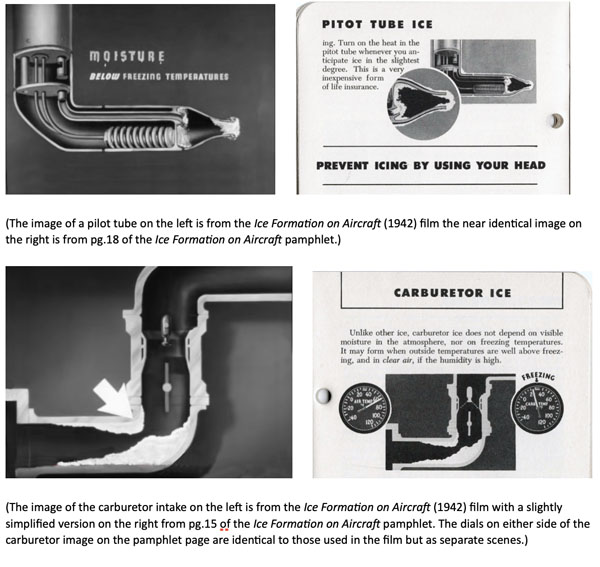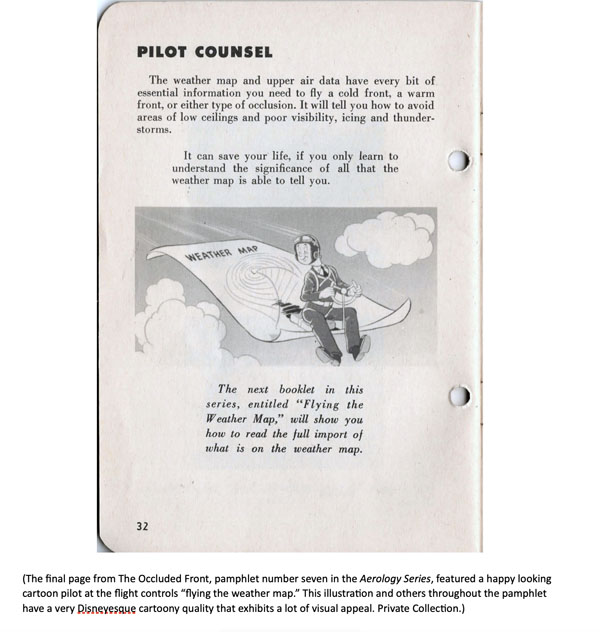
Walt Disney pitching storyboards for the U.S. Navy training film titled WEATHER AT WAR to a group of Navy
officers and Disney Studios artists in 1943. Photo Private Collection.
Outside, the “storm of the century” was bearing down with rain and increasing winds. The forecast called for snow, a rare occurrence in Los Angeles, and the term “snowmageddon” was being bantered about in some parts of the country. It just seemed like an appropriate time to stay inside and write about the Disney World War Two (WWII) Weather films and associated pamphlets.
The United States entered WWII on December 7, 1941, in the wake of the Japanese sneak attack on Pearl Harbor, Hawaii. But the Walt Disney Studios had already felt the economic effects of the war raging in Europe for several years since the Nazi invasion of Poland on September 1, 1939.(1) As other European countries were invaded and occupied by Nazi Germany, Disney’s film revenues were choked off from those territories. That motivated Walt Disney to look for other avenues to exploit animation and keep his studio afloat financially. This led to the studio creating more than 200 educational and training films for the United States Government and the U.S. Armed Forces.

Three of the weather pamphlets in the U.S. Navy’s Aerology Series based on the films produced by Walt Disney Productions during WWII. Private Collection.
One topic covered by Disney was weather in the Aerology Series of films for the U.S. Navy which began with two titles created in 1942, Ice Formation on Aircraft and Fog. These titles were followed in 1943 with Air Masses and Fronts, The Cold Front, The Occluded Front, Thunderstorms, The Warm Front, V.T.B. Pilot Training, Flying the Weather Map, Pt. 1 & 2: The Equatorial Front, and Flying the Weather Map, Pt. 3 & 4: The Howgozit Chart. And in 1944 the films Weather for the Navigator and Weather at War completed the series.(1)(2)
Once the individual films were completed by Disney, the Navy created small pamphlets for each of the titles. These were distributed to pilots and flight crews as quick reference guides that could be carried with them onboard the planes. The pamphlets used the graphic imagery derived from the films and supplemented with additional images. This a great example of repurposed and redrawn artwork by the Navy after the Disney Studios created the films.

Animated diagrams like the ones shown above from “The Occluded Front” (1943) are used both in the film and then repurposed as still images for these pamphlets either directly or inspired by the film images. Private Collection.
It’s curious though that there is no credit or even a reference given to Walt Disney Productions for creating the animated counterparts to these pamphlets. The pamphlets are credited as “PREPARED BY AVIATION TRAINING DIVISION, OFFICE OF THE CHIEF OF NAVAL OPERATIONS U.S. NAVY.”(4) That lack of credit or reference is likely why no one has written about these pamphlets as part of the Disney WWII history. Identifying the relationship of this material to Disney requires first making the initial connection, and then matching up film and pamphlet images for confirmation.
Once many of these military films were completed at Disney, much of the artwork, film, and negatives were removed from the Studio. This was especially done on the restricted or sensitive title that dealt with bomb sites, auto pilot, and related subjects.

High Level Precision Bombing title cards, Prod. 2681, 1943.
Titles like the Minneapolis Honeywell Project, High Level Precision Bombing, and Fixed Gunnery and Fighter Tactics(5) were some of the restricted films made at Disney using separate production teams. Each team worked on a specific segment of the film with no one group of artists knowing what the entire film was about for security. Once the film was completed, the military removed all the artwork, film, and negatives from the Studio.
However, some pieces of artwork have survived, typically non-descript backgrounds, in the Disney Animation Research Library (ARL).(6) Yet, those surviving pieces of art are very few in comparison to the voluminous amount of training films produced at the Walt Disney Studios during the war years.
To get a sense of just how much artwork Disney produced all one must do is look through the Aerology Series of pamphlets. Each volume produced is profusely illustrated with still images, many of which correspond directly to the Disney film counterpart. For example, look at the following images that compare film frames with corresponding images found in the pamphlets.

Not all the Disney Aerology Series films artwork translated to the pamphlets. In some instances, for example pamphlet number three, FOG, which is based on the film FOG (1942), did not utilize much of the film’s artwork directly. Instead, the pamphlet illustrations were inspired by what was animated in the film. This was likely because many of the animated scenes used special effects and camera techniques that were unique to animation and not necessarily appropriate or readable visually in print. Hence the need to reinterpret the animated scenes for static still images for these pamphlets.

The pamphlets were designed to be compact and easy to use, making them ideal for quick reference in the field. The use of visual aids and diagrams made complex concepts easier to understand and remember, helping pilots and flight crews prepare for a variety of weather conditions.
As a result of Disney’s efforts, the U.S. Navy had access to a wealth of high-quality training materials that were both informative and engaging. The success of the Aerology Series and other wartime productions paved the way for Disney’s later involvement in educational films, particularly those aimed at children.
The Aerology Series of films and pamphlets, in particular, offer valuable insights into how Disney’s unique blend of art and technology was adapted for military use. Despite the loss of some of the artwork and films, the surviving pieces serve as a testament to Disney’s dedication to the war effort and its commitment to innovation and creativity.
©2023-David Bossert
FOOTNOTES
1 United States Holocaust Memorial Museum, Holocaust Encyclopedia: World War II Dates and Timeline; https://encyclopedia.ushmm.org/content/en/article/world-war-ii-key-dates
2 Donald Duck Joins Up, Richard Shale, University of Michigan, PH.D. Dissertation, 1976, Pg.289—294
3 Us War Department – Field Manual – List of Films, Filmstrips, And Recognition Slides (1945), National Archives author research.
4 U.S. Navy Aerology Series No. 1—8, 1942—1944, pg.1
5 Us War Department – Field Manual – List of Films, Filmstrips, And Recognition Slides (1945), National Archives.
6 Author Research.


 David A. Bossert is an award-winning artist, filmmaker, and author. He received his B.A. from CalArts School of Film and Video with a major in Character Animation. As a 32-year veteran of The Walt Disney Company, he contributed his talents to The Black Cauldron (1985), Who Framed Roger Rabbit (1988), The Little Mermaid (1989), Beauty and the Beast (1991), Aladdin (1992), Tim Burton’s The Nightmare Before Christmas (1993), The Lion King (1995), Fantasia/2000 (1999), and the Academy Award-nominated shorts Runaway Brain (1995), Dali/Disney Destino (2003), and Lorenzo (2004), among many others. Bossert is now an independent producer, creative director, and writer.
David A. Bossert is an award-winning artist, filmmaker, and author. He received his B.A. from CalArts School of Film and Video with a major in Character Animation. As a 32-year veteran of The Walt Disney Company, he contributed his talents to The Black Cauldron (1985), Who Framed Roger Rabbit (1988), The Little Mermaid (1989), Beauty and the Beast (1991), Aladdin (1992), Tim Burton’s The Nightmare Before Christmas (1993), The Lion King (1995), Fantasia/2000 (1999), and the Academy Award-nominated shorts Runaway Brain (1995), Dali/Disney Destino (2003), and Lorenzo (2004), among many others. Bossert is now an independent producer, creative director, and writer.













































































Walt Disney looks terribly glum in that photograph!
It’s odd that the Navy was still using the term “aerology” for the study of the atmosphere; it was old-fashioned even then and is seldom used today. How many of the films in the Aerology Series have survived to this day? And do the films themselves carry a credit for Walt Disney Productions?
Hi Paul,
Over many years I managed to find prints of Air Masses and Fronts, The Cold Front, The Occluded Front, Flying the Weather Map and The Howgozit Chart (Pt. 3). There are more titles around on various DVDr discs from collectors. Colors on the prints are good, most are Kodachrome. I’ve lost a few of these Disney Navy films to vinegar syndrome. They are well-produced but most of them are pretty dull, not much character animation. They show mostly things like weather diagrams in nice color cycle technical animation, which in those days was all done on cel. Nowadays that type of animation is all done on computer. Get Dave’s “Disney at War” DVD set, it contains some Disney training films.He did a good job putting it together. My favorite is “Stop That Tank!” with some funny character animation by Ward Kimball, of Adolf Hitler yet!
Thanks for that additional information, Mark. I didn’t realise that these films were made in colour; I just assumed they were in black-and-white like the Pvt. Snafu cartoons et al.
Thanks, Mark!
I’d love to get copies of some of the weather films. Do you have digital versions, or would you consider having some of those digitized? You can email me separately if you want. Appreciate the info.
Best,
-Dave
Hi Paul,
I don’t know how many of the films have survived, but a number of them have survived, like The Occluded Front. Yes, those films do carry a Walt Disney Productions credit.
Thank you for reading the article.
-Dave
Disney almost got the contract for the Private Snafu shorts but their pitch was deemed too expensive
Has anyone found those MGM training films Tex and Bill and Joe have spoken of?
Hello Disney Fans
A few years ago, I was able to purchase a huge set of these films and some of those pamphlets shown in this article from an Italian collector. I’d be happy to share any of these with you if interested?
I have had poor health in the past year, and have decided to unload much of my collection to others for their own research.
please feel free to contact me if interested.
Hello Chris!
I teach High School Social Studies, including a course on how the Walt Disney Corporation has affected the US through the last 100 years. My student’s favorite unit is when we cover WWII propaganda and war training films. I would love to inherit any resources you’d be willing to share. If you’d send me an email, I’d love to further this conversation
annie.zelasko@gmail.com